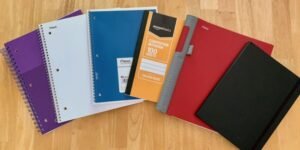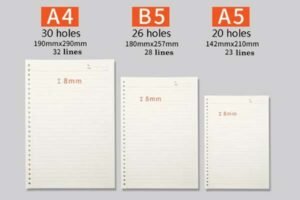
Are you tired of notebooks where the ink bleeds through or the binding falls apart? It's frustrating when a poor notebook ruins your notes or creative work. Finding a truly good notebook that suits your specific needs can make writing a pleasure again.
A good notebook features durable binding, high-quality paper1 that prevents ink bleed-through, and a design suitable for its intended use, like writing, sketching, or planning. It feels reliable and enhances your overall writing or creative experience.
So, what really makes a notebook stand out? It's more than just pages bound together. We look at the core components: the materials used for the cover and pages, how it's constructed (the binding method2), and if it fits the job you need it for. These elements together define if a notebook is just okay, or genuinely good. A well-made notebook feels sturdy, opens easily, and makes you want to use it.
Let's break that down a bit. First, materials are key. A strong cover, maybe hardcover or a durable flexible option, protects your notes. The paper inside matters most. We often talk about paper weight (like 80gsm or 100gsm) and if it's acid-free, which stops it from yellowing over time. Second, construction is vital. Does it lay flat? Is the binding secure, like a sewn spine or a strong metal coil? Finally, think about purpose. A pocket notebook needs to be portable, while a planner needs specific layouts.
How do you rate notebook quality?
Wondering how to tell if a notebook is actually high quality before you buy it? Let's look at the specific things you can check to judge its quality for yourself.
You rate notebook quality by checking the paper's weight (gsm) and smoothness, testing for ink bleed-through or ghosting, examining the binding's strength (does it lay flat?), assessing cover durability, and looking for overall neat craftsmanship.

Judging notebook quality involves looking closely at several details. It's not just about looks; functionality and durability are crucial. Think like a manufacturer for a moment – we obsess over these details because they define the user experience. You can apply some of the same checks we use.
Checking Key Quality Indicators
Let's explore how you can assess these quality points more critically.
Paper Quality Assessment
- Weight (GSM): Grams per Square Meter (gsm) tells you the paper's thickness and heft.
- Standard: Around 80gsm is common for everyday use. It's okay for ballpoints and pencils.
- Better Quality: 100gsm or 120gsm is thicker, feels more premium, and is much better for fountain pens or markers as it reduces bleed-through and ghosting (seeing the writing from the other side). At NotebookRing®, we often recommend 100gsm for clients wanting a superior writing feel.
- Smoothness & Finish: Rub the paper. Does it feel smooth? This affects writing comfort. Some paper has tooth (texture), better for sketching.
- Acid-Free: This prevents the paper from yellowing and becoming brittle over time. Essential for archiving notes or journals.
- Bleed-through Test: If possible, test with your favorite pens. Does the ink soak through to the other side? A good notebook minimizes this.
- Environmental Certification: Look for FSC™ (Forest Stewardship Council) certification. This means the paper comes from responsibly managed forests. We are proud to hold FSC™ certification3 (C106904).
Binding and Construction Evaluation
- Binding Type:
- Sewn Binding: Pages are stitched together in sections (signatures). Very durable, often allows the notebook to lay flat. Our German client loves this for their 180° flat-design notebooks.
- Spiral/Coil Binding: Allows 360-degree rotation. Look for sturdy wire. We developed a patented "seamless coil" to avoid snagging.
- Glue Binding (Perfect Binding): Pages are glued at the spine. Quality varies greatly; strong, flexible glue is needed.
- Binder Systems: Refillable 6-ring, 20-ring, etc. Check the ring mechanism quality (should snap securely) and hole alignment. We ensure compatibility with standards like Filofax and Campus.
- Lay-Flat Capability: Does the notebook stay open easily on a desk? This is crucial for comfortable writing.
- Construction Neatness: Look for clean edges, correctly aligned pages, no excess glue, and a securely attached cover.
Cover Material and Durability
- Material: Cardboard, plastic (PP), fabric, leatherette? Choose based on needed durability and feel. We offer options from sturdy PP to eco-friendly bagasse fiber covers.
- Finish: Consider details like hot stamping, embossing, or laser engraving for customization and aesthetic appeal. These add a touch of quality and personalization, which are popular for corporate gifts.
- Overall Sturdiness: Does the cover feel like it will protect the pages well? Does it resist bending easily?
Putting it Together: The Rating Checklist
You can think of it like a simple checklist:
| Feature | What to Check | Importance Level |
|---|---|---|
| Paper Weight | 80gsm (good), 100gsm+ (better) | High |
| Paper Feel | Smoothness, Bleed/Ghosting Test | High |
| Acid-Free | Yes (for longevity) | Medium to High |
| Binding | Type suits use, Lays Flat, Secure Pages | High |
| Cover | Durable Material, Sturdy Construction | Medium to High |
| Craftsmanship | Neat Edges, Clean Glue Lines, Alignment | Medium |
| Certification | FSC™, ISO, etc. (indicator of responsible mfg.) | Medium |
Using criteria like these helps you move beyond just picking a notebook that looks nice. You can start identifying notebooks that are genuinely well-made and suited for what you need.
Finding Your Perfect Notebook Partner: NotebookRing®
Speaking of quality and finding the right notebook, sometimes you need something specific that you can't find off the shelf. Maybe it's a unique size, a special paper type, or a branded cover for your business. That's where working directly with a manufacturer like us, NotebookRing®, comes in.
Since 2006, we've focused solely on crafting professional notebooks and binders. Our 15,000㎡ factory in Wenzhou is equipped for the whole process, from paper processing to final binding, and we hold certifications like FSC™, ISO 9001, and BSCI. This means we control quality every step of the way.
We specialize in customization. Need hot stamping on the cover? Done. Want 100gsm acid-free paper with dot grid pages? Easy. Need a specific 26-hole binder system? We make those too, compatible with international standards. We work with clients ranging from German bookstores needing eco-friendly notebooks to Silicon Valley tech firms ordering custom onboarding kits, and Japanese brands developing niche products. We offer flexibility, even for smaller orders (starting from 100 units for basic versions), and provide clear pricing ($0.84-$1.7 for 1k+ units, $0.63-$1.3 for 10k+ units, with transparent costs for upgrades).
If you're looking for high-quality, customized notebooks or binders, especially with sustainable options and reliable global logistics, we're here to help.
Conclusion
Ultimately, a good notebook has quality paper and durable binding, tailored to your needs. Rating one involves checking paper weight, testing for bleed-through, examining the binding strength, and assessing the overall build quality and materials.
-
Explore the advantages of high-quality paper for a better writing experience and to prevent ink bleed-through. ↩
-
Learn about various binding methods to choose a notebook that suits your writing style and needs. ↩
-
Discover the importance of FSC™ certification for sustainable and responsibly sourced paper products. ↩





